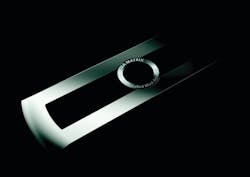IRMA-Matrix: The New Dimension for Most Accurate APC
Automatic Passenger Counter (APC) systems and solutions usually make use of infrared sensing technologies. The most common technology is “active infrared” where the APC sensor sends out infrared light, which is reflected by the passengers moving through the detection range.
The active-infrared sensor system is working reliably in the 95 percent accuracy range when the operations conditions are normal. However, the conditions are not always normal. For example, queuing underneath the sensor, bunching in tightly packed crowds, stanchion in the doorway, reflecting vehicle floors, ambient light, extreme sun/shade contrast or extremely high temperatures can make life difficult for the sensor and affect the count accuracy.
To maintain the comparatively cost-effective infrared detection means, but overcome the accuracy and reliability issues, IRIS-GmbH Infrared & Intelligent Sensors, the manufacturer of the Infrared Motion Analyzer (IRMA) APC systems, developed the new IRMA-Matrix sensor system, based on the modern time-of-flight (TOF) technology.
IRMA-Matrix Sensor
IRMA-Matrix makes use of the speed of light to detect and evaluate true distance and shape/contour data. By using a matrix of 500 detection pixels, the sensor accommodates the fact that passengers have three dimensions and produces 3D images instead of 2D contrasts of the detection area and the people and/or objects in the field of view.As the transit time of light is a constant, TOF is a robust technology, not affected by environmental conditions.
The new IRMA Matrix sensor represents the high-end version of the IRIS APC portfolio and produces the highest possible count accuracy achievable by means of infrared. Due to its 20 x 25 imaging data per sensor (matrix sensor), the sensor "sees" the door area, i.e., it works like a camera.
Image of Passenger in Doorway
The following features are significant for the IRMA-MATRIX sensor system:
• Compact processor for counting and signal processing. The analyzer features are integrated into the sensor. The sensor is directly connected to the onboard system.
• Easy adjustment to the door condition, no post-installation calibration required.
• Self-recognition of the door status. Door contact cables are no longer required. The sensor system simply needs a switch-on/switch-off message, e.g., generated by the on-board system.
• Precise counting due to extreme high quality of the signal information. The observed count accuracy is 99+ percent without onboard data manipulation.
• Classification of the passengers according to their body height. This allows, for instance, to exclude people under 1m from counting because they do not pay fares.
• Recognition of bunching, queuing and/or simultaneous boarding/de-boarding, i.e., exact counting at high-frequented stops and/or extra-wide doors.
• Recognition of passengers rocking back and forth underneath the sensor, e.g., when waiting in front of the farebox.
• Recognition of wheelchairs, i.e., wheelchair switches are no longer required.
• Recognition of objects such as trolley, stroller, bicycle.
• Recognition of the door open/door closed cycles at un-scheduled locations or detours.
• Recording of the number of passengers on board, storage of up to 14 days of recorded APC data.
• Diagnostic and status communication to the on-board system.
Note: The better the count accuracy of the raw data, the less use of presumptions, probabilities, error filtering or “accuracy push-up” is required when transferring the counts into reports.
IRMA-Matrix has already made its breakthrough in the transit industry due to its robustness and the high out-of-the-box count accuracy. The IRMA-Matrix sensor is provided as flush mount or surface mount version. Connection to the on-board system is possible via ETHERNET or CAN. In case of need, a gateway can be provided for connection to the J1708, RS485 or customized environment.
The integration with the onboard system is performed by means of the IRIS-provided Application Programming Interface (API), optional on a Windows or Linux or OSX platform.
